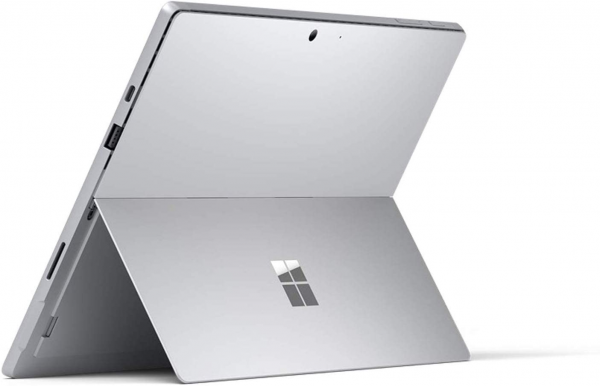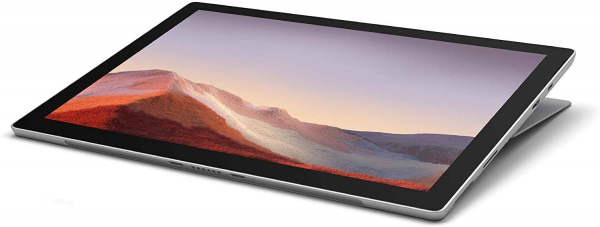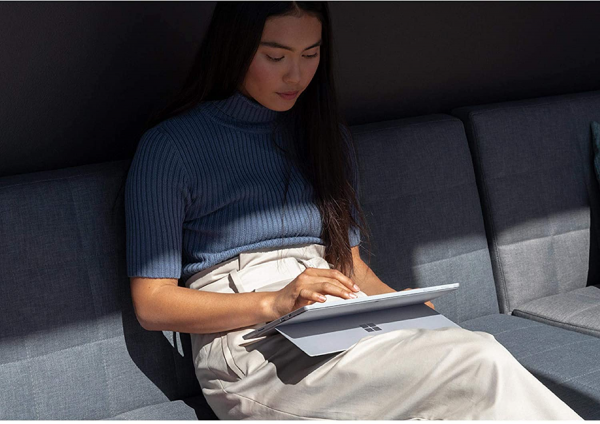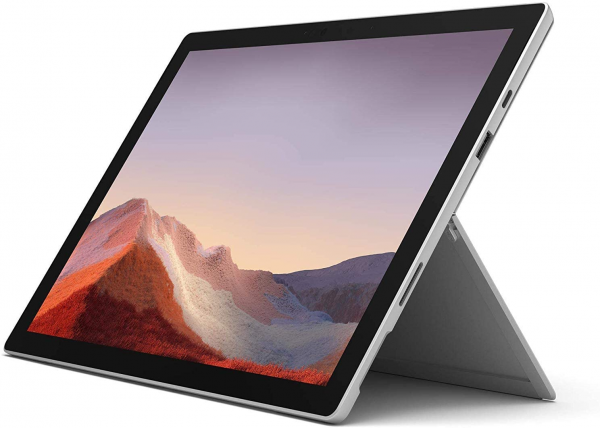Microsoft
Microsoft Surface Pro 7: a technically flawless hybrid computer
Aprox. 1059€
See specificationsMicrosoft's flagship product since 2012, the Surface Pro is in its 7th version. No revolution with this model, but a logical refresh. Microsoft has accustomed us to technically excellent products. Is this still the case here?
Our review
Presentation
A real revolution when it was released in 2012, thanks to the idea of combining a PC and a tablet, the Microsoft Surface Pro has continued to sell until today. If the computer has of course technically evolved over the years, the format has remained the same. The Redmond company still offers a tablet with a keyboard and a stylus sold separately. Today, Microsoft's catalog includes the Surface Pro X, adopting the same format but equipped with an ARM CPU, as well as a real complete laptop, the Surface Laptop 3. The Surface Pro 7 seems to be the compromise between two products.
This 12.3-inch tablet has a 10th generation Intel Core processor with an Iris Plus integrated graphics circuit that promises a small reserve of graphics power. Latest innovation, the presence of a USB Type-C port, which makes its entry for the first time on the machine. It remains to be seen if Microsoft has treated its Surface, and if it still has its place on the market in 2020.

Construction
"If it's not broken, don't fix it," says an American saying. A precept that perfectly suits this Surface Pro 7. The magnesium chassis changes little in this new version, Microsoft is content to touch up the design very slightly so that it is difficult to differentiate it from the previous model. We thus find the ventilation grilles which run on all the slices of the product as well as the physical buttons and the connector of the keyboard. The 160 ° retractable foot is also always present to tilt the tablet at will. As always, it is impossible to open the product in order to change parts. We will therefore have to be satisfied with the configuration purchased during its entire lifetime.
The Surface Pro 7 is primarily a tablet, and that's the crux of the problem. To purchase a keyboard, mouse or stylus, you will have to pay additional fees. Difficult to recommend the product alone, as Windows 10 in touch mode is limited. Note, however, that the old keyboard models are compatible with this new machine. But in the case of the purchase of a first Surface, it will be necessary to pay an additional € 150 minimum. Thus, the starting price of the product fixed at 779 € by Microsoft is a bit misleading. And it would not be surprising if unsophisticated people control the Surface Pro 7 without knowing that the keyboard is not included.
Our test model has a Signature keyboard in Alcantara (synthetic fabric soft to the touch) sold at 180 €, but it is possible to opt for a classic keyboard at 150 €. It connects to the tablet thanks to a very efficient and practical magnetic attachment. It can also be laid flat or be slightly raised for better typing comfort. Last point, it also serves as a screen protector like a cover.
The Signature keyboard is an example to follow in this area, as it is pleasant with its stroke of just length and its perfect resistance under the fingers. The keyboard is backlit on three levels and without a numeric keypad, which makes sense on such a small size. The trackpad also enjoys an impeccable finish, and responds perfectly to user requests, whether for clicks, two-finger navigation or when scrolling pages. The keyboard (like the tablet, moreover) does not offer a fingerprint sensor to lock its session. Microsoft has however armed the Surface Pro 7 with unlocking by facial recognition via Windows Hello. A process that works perfectly, the Surface opening a session almost instantly once the user stands in front of the screen.
The appearance of a USB 3.1 Type-C port is one of the novelties of this 2019 model. On the edges, we also find the eternal USB 3.0 Type-A port as well as a microSD card reader (hidden under the foot) in addition to a headset port. To recharge the tablet, Microsoft always places its Surface Connect there, a magnetic power port that holds well, even during handling. Note that the tablet offers an additional USB 3.0 Type-A port on the power supply, which is significant.
Our Surface Pro 7 is powered by a low-power 10th generation Intel Core i5-1035G4 processor. During a 30-minute gaming session on Diablo 3, the processor reached an average temperature of 62 ° C. The cooling system is efficient, evacuating air from all sides of the tablet and distributing the heat well. Thus, the magnesium chassis does not rise to more than 41 ° C, which is little in the middle of work. Since the PC has a passive cooling system, it works completely inaudible.

Screen
Surface Pro 7 has an unusual 12.3-inch touchscreen IPS panel. It adopts a 3: 2 ratio with a definition of 2,736 x 1,824 px. Microsoft does not put here on thin screen edges, the tablet offering a screen / front ratio of 77%, a bit low today for a high-end product. On the upper edge, we find a 5 megapixel webcam capable of filming in 1080p.
Microsoft has always accustomed us to very well calibrated screens on its Surface, and this version is no exception. We can certainly regret the persistence of 18 ms a little high (which has the consequence of leaving fuzzy streaks during movements - disturbing for some people), but, for the rest, there is not much to it reproach.
Measured at 1330: 1, the contrast is good for a laptop. The color temperature is very fair at 6,440 K, almost at the level of 6,500 K of the video standard. On a screen showing only white, the screen does not tilt towards red or blue. Respect for colors is to be welcomed here with an average delta E of 1.9. Thus, the colors displayed on the screen are very faithful to the original colors. Finally, the maximum brightness is 432 cd / m², which is high and slightly compensates for a tile subject to reflections with a fairly high reflectance of 51%. It will still be difficult to work outside in the bright sun.

Performances
Analyzing the performance of the Surface Pro 7 gave us a bit more trouble than usual. Indeed, in theory, the results should have been very close to those of a Surface Laptop 3, the two products having the same CPU configuration, a Core i5 Ice Lake 4 cores / 8 threads. However, the Surface Pro 7 was surprisingly quick on some of our tests (it was particularly familiar with the i7 Ice Lake ranges under Cinebench 15) while its encoding results were less good than expected. After several confirmation tests, it turns out that the discrepancies noted are due to the specifics of each cooling system: the Surface Pro 7 offers a passive system, while the Surface Laptop 3 is based on an active system with fan.
From then on, the regulation of each product works as follows: during a charging phase, the Surface Pro 7 will play on a certain dissipation inertia to maintain its maximum frequency for as long as possible. The Surface Laptop 3, meanwhile, has an easier time regulating its frequency. The system will therefore seek to quickly find a stabilized and optimal frequency. This point benefits the Surface Pro 7 over our very short tests such as Cinebench 15.
On longer tests, there is an opposite effect. Once each CPU has reached its set temperature, regulation must take place. However, in the case of passive cooling of the Surface Pro 7, the latter can only play on the reduction of the frequency, which must then be very restrictive to limit the risks of overheating. The Surface Laptop 3, thanks to its fan, can allow finer regulation, and a lower drop in the operating frequency. In the end, the two machines will find the same stabilization range, between 1,650 MHz and 1,700 MHz, but the Surface Laptop 3 will go through several stages before getting there, while the Surface Pro 7 will find a more direct route.
Keep in mind that, beyond these specifics of operation, the Surface pro 7 exploits its processor well, with a performance index of 57. In comparison, the Surface Laptop 3 reached 55 points. Overall, the laptop is responsive and remains pleasant to use on a daily basis.
On the GPU part, the two Surface products differ: the Surface Pro 7 integrates an iGP Iris Plus G4, against an iGP G7. The operating frequencies are substantially identical (around 500 to 650 MHz depending on the game), but the number of calculation units is to the advantage of the G7: 64 EU against 48 EU. In fact, the performances will remain fairly similar: 22 fps for Diablo 3 and 28 fps for Overwatch. There is better compared to iGP Intel HD620, but the video game activity remains clearly confined to titles that are not very greedy.

Mobility / Autonomy
Surface Pro 7 is a product designed for ultra mobility. Difficult indeed to make a more portable computer with its 12-inch screen that fits into any small bag and its weight of 780 g without the keyboard. By adding the keyboard, the PC is not much heavier, weighing just 1.1 kg, which is very light for an ultraportable. The charger is not larger than that of a smartphone and also focuses on lightness with a featherweight of 290 g.
Autonomy is also to be welcomed for a tablet. During our usual autonomy test, that is to say Netflix under Chrome with the screen brightness set to 200 cd / m², the Surface Pro 7 went out after 8 h 34 min. If it does not compete with the market champions, namely the MacBook Pro which easily exceed 10 hours, the Microsoft PC will bring comfort in this area. The user can leave the charger at home during a working day without fear of a battery failure in the middle of the afternoon. Note also that the tablet has Always-on mode, which means that it stays on no matter what happens until the user turns it off. Thus, it instantly wakes up from sleep with windows or previously used software already open. This has a minor impact on the battery since, during our test, it lost 5% of charge only overnight. Finally, fast charging via Surface Connect is also very significant, given that the battery is fully recharged in 2 hours.
Audio
The audio part of the Surface Pro 7 is exemplary and worthy of the best tablets on the market. Placed on the front on either side of the screen, the speakers do not have much to blame. They provide balanced sound, and stereo is excellent. There is also no distortion to be complained about.
The Surface Pro 7 also has a good headphone jack. Note however that the power will limit its use with nomad headsets only, and that the distortion is slightly high, which is a bit of a shame, but far from being catastrophic.
Conclusion
Microsoft always delivers a technically very successful product, almost free from reproaches on this point. The Surface Pro 7 remains a safe bet on the market and will follow those looking for a powerful two-in-one with a durable battery. However, keep in mind that it is sold as a tablet and that the keyboard must be purchased at an additional cost.
Specifications

